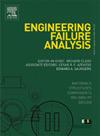CO2含量对P110地下储氢钢氢脆敏感性的影响:实验与DFT计算
IF 5.7
2区 工程技术
Q1 ENGINEERING, MECHANICAL
引用次数: 0
摘要
地下储氢的使用使大规模和经济高效的储氢成为可能。然而,地下储氢库中二氧化碳的存在会影响氢气与油管材料之间的相互作用。通过疲劳裂纹扩展速率(FCGR)实验和密度泛函理论(DFT)计算相结合的方法,研究了不同CO2浓度对P110钢氢辅助开裂的影响。实验结果表明,与纯氢相比,CO2的存在加速了FCGR。随着CO2浓度的增加,fgr先升高后下降,在0.008 MPa CO2 + 7.992 MPa H2 (0.1 vol% CO2 + H2)时达到峰值。此外,CO2的存在促进了氢加速疲劳裂纹扩展的临界应力强度因子的出现,使转折点从27 MPa·m1/2向前推进到约17 MPa·m1/2。DFT计算表明,随着CO2在氢气环境中的分压升高,氢溶解活化能先减小后增大。这表明氢渗透到钢表面的容易程度先降低后增加,与实验结果一致。本文章由计算机程序翻译,如有差异,请以英文原文为准。
Content dependence of CO2 effect on the hydrogen embrittlement sensitivity of P110 steel for underground hydrogen storage: Experiments and DFT calculations
The use of underground hydrogen storage enables large-scale and cost-effective storage of hydrogen. However, the presence of carbon dioxide (CO2) in underground hydrogen reservoirs can influence the interaction between hydrogen and the tubing materials. This study investigated the effects of varying CO2 concentrations on the hydrogen-assisted cracking in P110 steel by a combined study of fatigue crack growth rate (FCGR) experiments and density functional theory (DFT) calculations. Experimental results indicated that the presence of CO2 accelerates the FCGR compared to pure hydrogen. As the concentration of CO2 increased, the FCGR initially rose and then declined, peaking in 0.008 MPa CO2 + 7.992 MPa H2 (0.1 vol% CO2 + H2). Additionally, the presence of CO2 promoted the emergence of the critical stress intensity factor for hydrogen-accelerated fatigue crack growth, bringing the turning point forward from 27 MPa·m1/2 to approximately 17 MPa·m1/2. DFT calculations elucidated that the activation energy for hydrogen dissolution first decreased and then increased as the partial pressure of CO2 in the hydrogen environment rose. This suggested that the ease of hydrogen permeation into the steel surface initially decreased and then increased, in alignment with the experimental findings.
求助全文
通过发布文献求助,成功后即可免费获取论文全文。
去求助
来源期刊

Engineering Failure Analysis
工程技术-材料科学:表征与测试
CiteScore
7.70
自引率
20.00%
发文量
956
审稿时长
47 days
期刊介绍:
Engineering Failure Analysis publishes research papers describing the analysis of engineering failures and related studies.
Papers relating to the structure, properties and behaviour of engineering materials are encouraged, particularly those which also involve the detailed application of materials parameters to problems in engineering structures, components and design. In addition to the area of materials engineering, the interacting fields of mechanical, manufacturing, aeronautical, civil, chemical, corrosion and design engineering are considered relevant. Activity should be directed at analysing engineering failures and carrying out research to help reduce the incidences of failures and to extend the operating horizons of engineering materials.
Emphasis is placed on the mechanical properties of materials and their behaviour when influenced by structure, process and environment. Metallic, polymeric, ceramic and natural materials are all included and the application of these materials to real engineering situations should be emphasised. The use of a case-study based approach is also encouraged.
Engineering Failure Analysis provides essential reference material and critical feedback into the design process thereby contributing to the prevention of engineering failures in the future. All submissions will be subject to peer review from leading experts in the field.
 求助内容:
求助内容: 应助结果提醒方式:
应助结果提醒方式:


